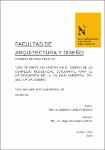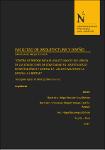Mostrar el registro sencillo del ítem
Estrategias pasivas de integración al entorno natural para el diseño de un terminal terrestre interprovincial en la ciudad de Cartavio en el 2019
| dc.contributor.advisor | Llanos Chuquipoma, Alberto Carlos | |
| dc.contributor.author | Caballero Osorio, Deivy Raúl | |
| dc.date.accessioned | 2021-04-22T15:31:42Z | |
| dc.date.available | 2021-04-22T15:31:42Z | |
| dc.date.issued | 2020-10-07 | |
| dc.identifier.citation | Caballero, D. R. (2020). Estrategias pasivas de integración al entorno natural para el diseño de un terminal terrestre interprovincial en la ciudad de Cartavio en el 2019 (Tesis de licenciatura). Repositorio de la Universidad Privada del Norte. Recuperado de https://hdl.handle.net/11537/25787 | es_PE |
| dc.identifier.other | 711.4 CABA 2020 | es_PE |
| dc.identifier.uri | https://hdl.handle.net/11537/25787 | |
| dc.description.abstract | Se elabora una bibliografía como base para una propuesta arquitectónica, en base a estrategias pasivas de integración al entorno natural, evaluando soluciones con respecto al uso y aplicación de plazas de integración, cubiertas verdes y terrazas ajardinas tanto en el espacio exterior del edificio como en el interior, el cual debe solucionar previamente la integración del entorno con el objeto arquitectónico. Es por ello, que se generaran recorridos paisajísticos verdes que inicien desde un primer nivel y lleguen a niveles superiores, los mismos, con los que se va generar una integración del edificio con el exterior en búsqueda que el edificio no genere un impacto en zonas verdes. Las plazas tipo calle, plaza tipo vestíbulo y plaza tipo alameda ayudaran a lograr un área con mayor vegetación en el exterior, interrelacionándose entre sí, generando un recorrido verde, además ayudara a integrarse de mejor forma al edificio con el exterior, además van ayudar a mejorar la relación urbana ya existente de modo que no afecte drásticamente con el volumen que se va implantar. Además, se van aplicar patios verdes, terrazas ajardinadas y plazas con piletas dando un carácter de plaza oasis en el interior del edificio, teniendo entre ellos una continuidad visual para logar integrar el espacio interior con los patios, a la misma vez tenga una relación unitaria entre el hombre con la naturaleza. Las estrategias pasivas de integración al entorno natural viabilizan la propuesta arquitectónica, al ser soluciones pasivas que no presenten un impacto en el área urbana ya existente. | es_PE |
| dc.description.abstract | A bibliography is prepared as the basis for an architectural proposal, based on passive strategies of integration into the natural environment, evaluating solutions regarding the use and application of integration squares, green roofs and garden terraces both in the exterior space of the building and in the interior, which must previously modify the integration of the environment with the architectural object. That is why, green landscape tours that start from a first level and reach higher levels are generated, the same, with which an integration of the building with the exterior will be generated in search that the building does not generate an impact on green areas . The street-type squares, the lobby-type square and the mall-type square help to achieve an area with more vegetation on the outside, interacting with each other, generating a green route, it also helps to better integrate the building with the outside, and they will also help to improve the urban and existing relationship so that it does not drastically affect the volume to be implanted. In addition, green patios, landscaped terraces and squares with pools will be applied giving an oasis plaza character inside the building, having between them a visual continuity to achieve integration of the interior space with the patios, at the same time having a relationship unitary between man and nature. Passive integration strategies to the natural environment make the architectural proposal viable, as they are passive solutions that do not have an impact on the existing urban area. | es_PE |
| dc.description.uri | Tesis | es_PE |
| dc.format | application/pdf | es_PE |
| dc.format | application/msword | es_PE |
| dc.language.iso | spa | es_PE |
| dc.publisher | Universidad Privada del Norte | es_PE |
| dc.rights | info:eu-repo/semantics/closedAccess | es_PE |
| dc.rights | Atribución-NoComercial-CompartirIgual 3.0 Estados Unidos de América | * |
| dc.rights.uri | https://creativecommons.org/licenses/by-nc-sa/3.0/us/ | * |
| dc.source | Universidad Privada del Norte | es_PE |
| dc.source | Repositorio Institucional - UPN | es_PE |
| dc.subject | Perú | es_PE |
| dc.subject | Urbanismo | es_PE |
| dc.subject | Diseño urbano | es_PE |
| dc.subject | Evaluación del impacto ambiental | es_PE |
| dc.title | Estrategias pasivas de integración al entorno natural para el diseño de un terminal terrestre interprovincial en la ciudad de Cartavio en el 2019 | es_PE |
| dc.type | info:eu-repo/semantics/bachelorThesis | es_PE |
| thesis.degree.grantor | Universidad Privada del Norte. Facultad de Arquitectura y Diseño | es_PE |
| thesis.degree.level | Título Profesional | es_PE |
| thesis.degree.discipline | Arquitectura y Urbanismo | es_PE |
| thesis.degree.name | Arquitecto | es_PE |
| dc.publisher.country | PE | es_PE |
| dc.subject.ocde | https://purl.org/pe-repo/ocde/ford#6.04.08 | es_PE |
| thesis.degree.program | Pregrado | es_PE |
| dc.description.sede | Trujillo El Molino | es_PE |
| renati.advisor.dni | 18143230 | |
| renati.advisor.orcid | https://orcid.org/0000-0001-7525-7669 | es_PE |
| renati.author.dni | 73666636 | |
| renati.discipline | 731156 | es_PE |
| renati.juror | Bocanegra Galván, Hugo Gualberto | |
| renati.juror | Ríos Gutierrez, Diego Antonio | |
| renati.juror | Torres Zavaleta, Fernando Alexander | |
| renati.level | https://purl.org/pe-repo/renati/level#tituloProfesional | es_PE |
| renati.type | https://purl.org/pe-repo/renati/type#tesis | es_PE |
Ficheros en el ítem
Este ítem aparece en la(s) siguiente(s) colección(ones)
-
Tesis [301]









